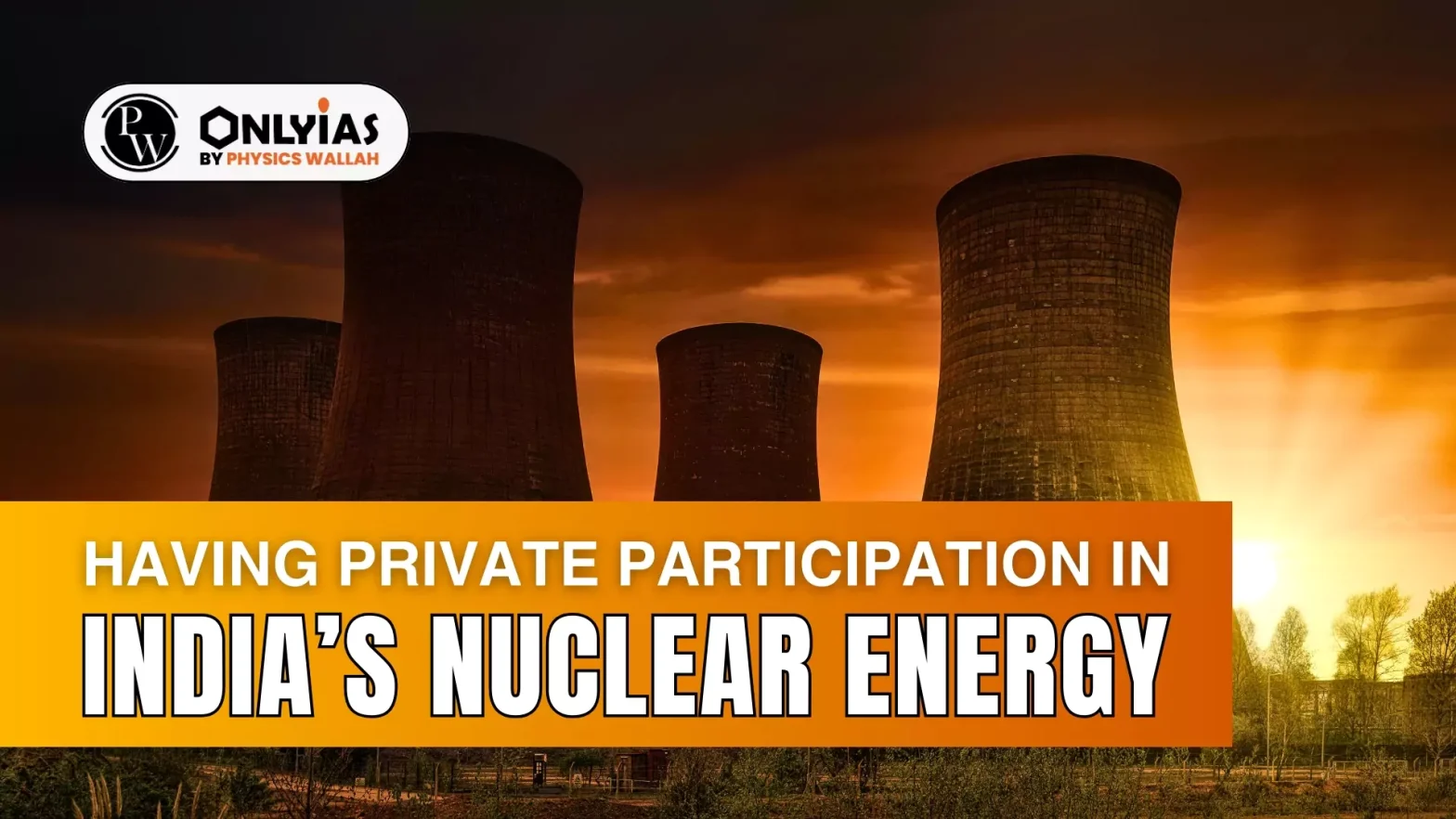In July 2024, during the presentation of the Union Budget for FY 2024-25, the Government of India announced significant initiatives aimed at expanding the country’s nuclear energy sector. This included proposals for partnerships with the private sector to research and develop Bharat Small Reactors (BSR) and Bharat Small Modular Reactors (BSMR), with a production capacity ranging from 30 to 300 MW, as well as advancements in newer nuclear energy technologies. This strategic move is presumably intended to fulfil India’s commitments made during the COP26 Summit in Glasgow in 2021, where the nation pledged to enhance its clean energy capabilities and reduce carbon emissions.
| Note:
Nuclear energy is generated through the process of nuclear fission, where the nucleus of an atom, typically uranium or plutonium, is split into smaller parts, releasing a significant amount of energy in the form of heat. This heat is used to produce steam that drives turbines, generating electricity in large quantities. While nuclear power plants can produce electricity on a massive scale and serve as a low-carbon energy source, they come with several associated risks, including the potential for catastrophic accidents, the challenge of managing radioactive waste, and concerns regarding nuclear proliferation. |
Enroll now for UPSC Online Course
Existing Framework Governing the Nuclear Sector
- The Atomic Energy Act, 1962 (AEA): The AEA, amended by the Atomic Energy (Amendment) Act, 1987 (No. 29 of 1987), is the primary governing statute overseeing the development and operation of the nuclear energy sector in India. Importantly, Section 3(a) of the AEA empowers only the central government to “produce, develop, use, and dispose of atomic energy,” establishing a monopoly for the central government over nuclear activities until now.
- Sandeep T.S. vs. Union of India & Ors. Case: In this case, the Supreme Court of India dismissed a petition challenging the provisions of the AEA that restrict the involvement of private entities in the licensing of nuclear power. The Court emphasised that nuclear power is inherently dangerous, thus asserting that only Parliament should regulate it. The Parliamentary regime is designed to ensure a calibrated exploitation of atomic power, subject to stringent safeguards, considering the potential consequences of misuse or accidents.
- Civil Liability for Nuclear Damage Act, 2010 (CLNDA): This act imposes liability on the company operating a nuclear power plant in the event of a nuclear accident, requiring them to provide compensation regardless of fault. Currently, there is a pending challenge to the constitutionality of the Civil Liability for Nuclear Damage Act, 2010 (CLNDA) in the Supreme Court.
- Critics argue that this provision poses a significant obstacle to attracting investment in the nuclear energy sector, as potential investors are deterred by the compliance requirement to accept liability even if they are not at fault.
| Note: It will be important to observe whether there will be additional challenges to the proposed government partnership with the private sector, as it may conflict with the Supreme Court’s judgement in the Sandeep T.S. vs. Union of India & Ors. case. The outcome of these challenges will depend on how the Supreme Court chooses to interpret its earlier ruling and whether it views the government’s new initiatives as consistent with the existing legal framework governing the nuclear energy sector. |
NITI Aayog Report- The Role of Small Modular Reactors (SMRs) in the Energy Transition
The Department of Atomic Energy (DAE) and NITI Aayog released a report titled “The Role of Small Modular Reactors (SMRs) in the Energy Transition,” which highlights the potential of SMRs in India’s energy landscape. The report emphasises two critical requirements for fostering private sector participation in the development and deployment of SMRs.
- Firstly, it calls for a conducive SMR regulatory framework that is led by national regulators, outlining clear guidelines on production standards and compliance measures. This framework would ensure that private entities understand the regulatory landscape and can operate within it effectively.
- Secondly, the report stresses the need for an unambiguous civil nuclear liability framework and a supporting legal structure. This framework should assure private sector entrants that liabilities and punishments would only apply in cases of negligence or wrongdoing, thereby encouraging sustainable and continuous engagement from private players in the nuclear energy sector.
Check Out UPSC Modules From PW Store
Current Involvement of the Private Sector
- The Nuclear Power Corporation of India Limited (NPCIL) has engaged the private sector primarily in areas such as engineering, procurement, and construction (EPC), as well as in the supply of materials for nuclear projects.
- For instance, companies like Megha Engineering & Infrastructures and Reliance have been involved in developing infrastructure for nuclear reactors.
- However, it is important to note that these private entities are not participating in core nuclear energy operations, which remain under the purview of NPCIL.
Way Ahead
- Joint Venture Approach: One potential way forward is to establish public-private partnerships in the form of joint ventures. In this structure, NPCIL or a similar government authority could retain 51% ownership of nuclear plants, in alignment with existing laws. This approach would invite private capital investment while ensuring that responsibility, ownership, and accountability remain with the government.
- Transparency and Accountability: Furthermore, entities with a majority government stake would fall under Section 2(h) of the Right to Information (RTI) Act, which mandates transparency.
- These entities would be required to make disclosures as outlined in Section 4 and respond to reasonable public inquiries under Section 6 of the RTI Act, thus ensuring public accountability.
This collaborative model presents a win-win situation for both the government and private sector, fostering investment while maintaining oversight and responsibility in the nuclear energy sector.
Enroll now for UPSC Online Classes
Conclusion
Thus, incorporating private participation in India’s nuclear energy sector can significantly enhance investment, innovation, and efficiency while ensuring stringent regulatory oversight. This collaborative approach not only supports India’s energy transition but also aligns with its commitments to sustainable development and reduced carbon emissions.
![]() 1 Oct 2024
1 Oct 2024

